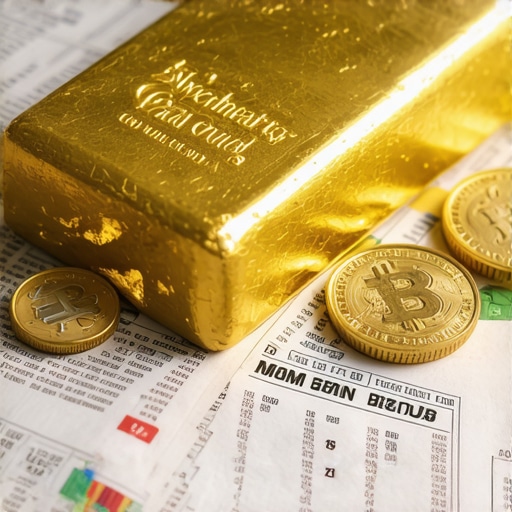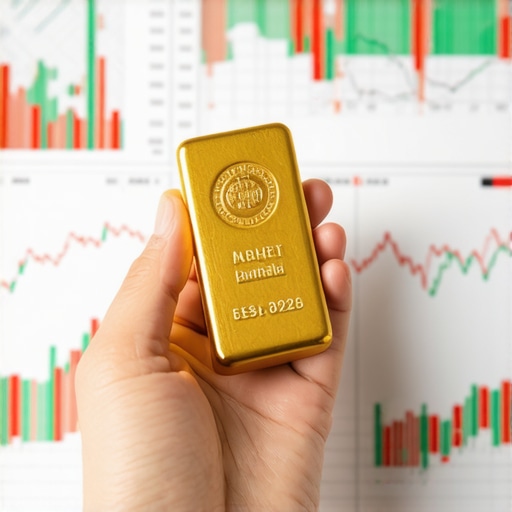Unlocking the Golden Gateway: Why Beginners Must Tread Carefully
Investing in gold is often hailed as a timeless strategy to preserve and grow wealth, especially in uncertain economic times. For beginners, the allure of gold’s stability and intrinsic value is compelling. Yet, without a nuanced understanding, new investors can easily fall prey to pitfalls that diminish returns or expose them to unnecessary risks. This article delves into the most common errors beginners make when investing in gold and offers expert insights to navigate this glittering yet complex market confidently.
Shining Beyond the Surface: Common Pitfalls in Gold Investing
Overlooking the Importance of Authenticity and Purity
One of the cardinal mistakes beginners make is neglecting to verify the authenticity and purity of physical gold. Not all gold is created equal, and the market is rife with counterfeit or substandard products. Understanding karat ratings and sourcing gold from reputable dealers is essential. For comprehensive guidance on safe gold purchases, consider exploring the Beginners Guide to Buying Gold Bars Safely.
Ignoring Market Dynamics and Timing
Gold prices fluctuate based on global economic indicators, currency strength, inflation expectations, and central bank policies. Beginners often buy impulsively during price surges, overlooking market cycles and demand trends. Developing a strategic approach informed by macroeconomic insights helps avoid costly timing errors. Detailed analysis on these trends can be found in Understanding Gold Demand Trends.
Creative Gold Allocation: Diversification Within Your Portfolio
Relying solely on physical gold can limit liquidity and potential returns. Savvy investors diversify by incorporating gold ETFs, mutual funds, and mining stocks, each with distinct risk profiles and performance drivers. Beginners often err by failing to explore these alternatives or misunderstanding their nuances. For a thorough breakdown, see Types of Gold Investments: Choosing the Right Vehicle for You.
What Are the Hidden Costs and Risks of Gold Investing That Beginners Should Know?
Beyond purchase price, costs such as storage fees, insurance, and dealer premiums can erode returns. Additionally, liquidity constraints and market volatility pose risks. Understanding these factors is crucial. Beginners should educate themselves about secure storage solutions and realistic expectations for market behavior. Resources like Best Physical Gold Investment Tips for Secure Ownership provide actionable advice.
Expert Wisdom: Real-Life Lessons from Gold Market Navigations
Consider the example of a new investor who purchased gold coins at a market peak without verifying dealer reputation. The coins were later found to have authenticity issues, resulting in a significant loss. Conversely, seasoned investors who diversified holdings and monitored macroeconomic signals managed to capitalize on gold’s safe-haven appeal during economic downturns. These lived experiences underscore the importance of informed, cautious investment strategies.
For authoritative market analysis and forecasting, the World Gold Council offers invaluable research and data, helping investors understand evolving demand and price influences.
Ready to deepen your gold investment knowledge? Dive into our Step-by-Step Guide to Investing in Gold for Beginners and start building a resilient portfolio today. Share your experiences or questions in the comments to join a community of insightful investors.
Learning from My Own Gold Journey: Mistakes and Milestones
Reflecting on my early days investing in gold, I realize how many lessons came from firsthand experience rather than theory. Initially, I was dazzled by the shiny allure and overlooked the nuances of market timing and diversification. My first purchase of physical gold bars taught me about the importance of secure storage — a costly lesson when I had to pay hefty fees for a safety deposit box at short notice. Later, diversifying into gold ETFs not only provided liquidity but also reduced my anxiety during volatile market swings.
Understanding the Impact of Global Events on Gold Prices
Gold’s price doesn’t exist in a vacuum; it’s shaped by a complex web of global economic and political events. For example, central bank policies, geopolitical tensions, and inflation rates all play significant roles. I found this particularly evident during times of unexpected crises, where gold often surged as a safe haven. A detailed explanation of how central bank gold purchases influence global prices can be found here. This insight helped me anticipate market movements better and avoid panic selling.
How Do You Decide Which Gold Investment Fits Your Personal Goals?
This question often crossed my mind, especially when faced with the myriad investment options like physical gold bars, coins, ETFs, and mutual funds. The choice boils down to your financial goals, risk tolerance, and preferred level of involvement. For instance, physical gold offers tangible security but requires careful handling and storage, while ETFs provide ease of trading and diversification without the logistical hassles. Exploring detailed comparisons such as Types of Gold Investments: Choosing the Right Vehicle for You helped me make informed decisions aligned with my portfolio strategy.
Do you have a favorite gold investment type or a story about your first gold purchase? I’d love to hear your experiences—feel free to share in the comments below. And if you’re looking for more practical advice, check out our Beginners Guide to Buying Gold Bars Safely, which offers step-by-step tips to avoid common pitfalls.
Decoding Sophisticated Risk Factors in Gold Investment Beyond the Basics
While beginners often focus on straightforward aspects like purity and timing, seasoned investors understand that gold’s risk profile is far more multifaceted. Beyond storage costs and price volatility, geopolitical shifts, currency fluctuations, and regulatory changes can dramatically impact returns. For example, changes in import-export tariffs or new taxation policies on precious metals can alter market dynamics overnight. Moreover, gold’s inverse correlation with certain asset classes means that shifts in global financial markets can either amplify or mitigate portfolio risk depending on allocation strategies.
Another advanced risk factor is counterparty risk in paper gold investments such as ETFs or gold-backed derivatives. Unlike physical gold, these instruments expose investors to the solvency and operational risks of the issuer, which can sometimes lead to liquidity crunches during market stress. Understanding these subtleties requires a deep dive into the issuer’s balance sheets and market positioning, often overlooked by those new to gold investing.
How Can Investors Mitigate Complex Risks While Maximizing Gold’s Portfolio Benefits?
Mitigating these intricate risks involves a combination of diversification within gold investments and active portfolio management. Allocating a portion of gold holdings to physical bullion while complementing with ETFs and mining equities can balance liquidity with exposure to growth opportunities. Coupling this with tactical adjustments based on macroeconomic indicators—such as interest rate movements, inflation trends, and geopolitical risk assessments—enables investors to dynamically hedge against downside risks.
Additionally, employing secure custody solutions and leveraging third-party audits can reduce physical gold’s storage and authenticity risks. Investors are also advised to stay abreast of regulatory changes by consulting authoritative sources like the World Gold Council, which provides detailed analyses and forecasts pivotal for making informed decisions.
Integrating Gold Into Multi-Asset Portfolios: Beyond Traditional Allocation Models
Contemporary portfolio theory suggests that gold’s unique risk-return characteristics make it an effective diversifier, but the degree to which it should be incorporated is subject to individual investment goals and market conditions. Modern approaches advocate for dynamic allocation models that adjust gold exposure based on real-time economic indicators and volatility metrics rather than static percentage allocations.
For instance, during periods of rising inflation or geopolitical uncertainty, increasing gold allocation can preserve capital and reduce portfolio drawdowns. Conversely, in bull markets for equities, reducing gold exposure may optimize returns. This nuanced approach requires continuous monitoring and sophisticated analytical tools, often employing machine learning algorithms to detect subtle market signals that precede price shifts.
Furthermore, investment in gold mining stocks or royalty companies introduces equity market risks alongside gold price sensitivity, providing opportunities for enhanced returns but requiring careful fundamental analysis. Understanding company-specific factors such as production costs, geopolitical risks in mining jurisdictions, and management track records becomes essential.
What Are the Cutting-Edge Analytical Techniques to Forecast Gold Price Movements?
Advanced investors increasingly turn to a combination of quantitative models and alternative data sources to forecast gold price trajectories. Techniques such as sentiment analysis on geopolitical news, currency strength indices, and supply-demand modeling integrate to create probabilistic forecasts. For example, machine learning models trained on historical gold price data alongside macroeconomic variables can identify non-linear relationships and emerging trends that conventional methods might miss.
Moreover, blockchain analytics tracking gold-backed tokens and transaction volumes offer new insights into market sentiment and liquidity flows. Coupling these with traditional fundamental analysis enhances forecast accuracy and informs tactical decision-making.
As you continue to refine your gold investment strategies, consider subscribing to specialized analytic services and engaging with expert communities focused on quantitative precious metals research. This ongoing education and network-building are invaluable for maintaining a competitive edge.
Harnessing Dynamic Allocation: Elevating Gold’s Role in Complex Portfolios
As portfolio management evolves beyond simple fixed allocations, incorporating gold requires nuanced understanding of its shifting correlations and risk mitigation potential. Sophisticated investors adopt dynamic allocation strategies that adapt exposure based on real-time macroeconomic indicators such as inflation expectations, interest rate trajectories, and geopolitical tensions. This flexibility allows portfolios to benefit from gold’s traditional safe-haven characteristics while seizing growth opportunities during market dislocations.
Integrating gold mining equities and royalty companies further diversifies exposure, but necessitates rigorous fundamental and geopolitical risk analysis. For instance, evaluating operational efficiencies, jurisdictional stability, and management quality can differentiate outperforming mining stocks from volatile peers.
Leveraging Machine Learning and Alternative Data in Gold Price Forecasting
Cutting-edge investors increasingly deploy machine learning algorithms to decode the complex interplay between gold prices and macro-financial variables. By assimilating historical price data with sentiment analysis from geopolitical news, currency strength indices, and supply-demand metrics, these models uncover non-linear patterns inaccessible to traditional econometric approaches.
Moreover, blockchain analytics tracking gold-backed token transactions provide real-time insights into market liquidity and investor sentiment shifts. This fusion of alternative data with conventional fundamental analysis elevates forecasting precision and informs timely portfolio adjustments.
How Can Quantitative Models and Alternative Data Sources Enhance Gold Investment Decisions?
Quantitative models, powered by artificial intelligence, can process vast, heterogeneous datasets to generate probabilistic forecasts of gold price trajectories. This enables investors to anticipate market inflection points and optimize entry and exit timing. Additionally, alternative data streams such as social media sentiment and blockchain transaction flows offer early signals of shifting investor behavior and liquidity conditions.
Engaging with specialized analytic platforms and expert quantitative research communities is crucial for investors aiming to harness these advanced tools effectively. The World Gold Council remains an authoritative source for comprehensive market data and forward-looking analyses that complement these innovative techniques.
Fortifying Gold Investments Against Emerging Risks: Regulatory and Technological Vigilance
Navigating the evolving regulatory landscape is imperative. Recent shifts in taxation policies, import-export controls, and financial compliance frameworks can swiftly alter gold investment returns. Proactive monitoring and adapting to these changes mitigate unforeseen exposures.
Technological advancements, including secure digital custody solutions and blockchain-based provenance verification, are transforming gold ownership paradigms. Adopting these innovations reduces risks related to authenticity, counterparty solvency, and physical storage, thereby enhancing overall portfolio resilience.

What Emerging Technologies Are Revolutionizing Gold Ownership and Risk Management?
Technologies such as blockchain-enabled provenance tracking and digital vaulting platforms are redefining transparency and security in gold investment. These innovations facilitate immutable verification of gold origin and ownership, minimizing fraud and counterparty risks.
Furthermore, digital custody services integrated with insurance and audit mechanisms provide seamless and secure access to physical gold holdings without the logistical burdens of traditional storage. Staying abreast of these technological trends empowers investors to safeguard assets while maintaining liquidity.
To explore these advanced insights and elevate your gold investment acumen, we invite you to join our expert community and access cutting-edge resources tailored for sophisticated investors.
Frequently Asked Questions (FAQ)
What is the safest way for beginners to purchase physical gold?
For beginners, the safest approach involves buying gold bars or coins from reputable dealers who provide certification of authenticity and purity. Verifying the karat rating (typically 24K for investment-grade gold) and opting for well-known brands or government-minted coins reduces counterfeit risks. Additionally, secure storage solutions such as insured vaults or safety deposit boxes are crucial to protect physical holdings.
How does gold fit into a diversified investment portfolio?
Gold acts as a hedge against inflation and currency volatility, often exhibiting low or negative correlation with equities and bonds. Incorporating gold—typically between 5% and 15% of a portfolio—can reduce overall volatility and drawdowns during market stress. Dynamic allocation strategies that adjust gold exposure based on economic conditions can further optimize portfolio resilience.
What are the key risks associated with gold ETFs compared to physical gold?
Gold ETFs offer liquidity and ease of trading but introduce counterparty and operational risks since investors do not hold physical gold directly. The value of ETFs depends on the issuer’s solvency and management of underlying assets. Conversely, physical gold requires secure storage and insurance but eliminates counterparty risk. Understanding these distinctions helps investors select instruments aligned with their risk tolerance.
How do global economic events influence gold prices?
Gold prices are sensitive to macroeconomic factors including central bank policies, inflation rates, currency fluctuations, geopolitical tensions, and financial market volatility. For example, during times of heightened geopolitical risk or inflationary pressures, gold typically appreciates as a safe-haven asset. Monitoring these indicators aids investors in timing purchases and sales strategically.
Can emerging technologies improve security and transparency in gold investment?
Yes. Blockchain-based provenance tracking and digital custody platforms enhance transparency by providing immutable records of gold origin and ownership, reducing fraud and counterparty risks. Digital vaulting services also simplify access and management of physical gold, combining security with liquidity benefits, making them increasingly valuable tools for modern investors.
How can machine learning and alternative data improve gold price forecasting?
Machine learning models analyze complex, non-linear relationships among historical prices, macroeconomic variables, and sentiment indicators from news and social media. Integrating alternative data such as blockchain transaction volumes provides deeper insights into market liquidity and investor behavior. These tools enable more accurate probabilistic forecasts and better-informed tactical decisions.
What hidden costs should investors consider when buying physical gold?
Beyond purchase price, investors must account for dealer premiums, storage fees, insurance costs, and potential resale discounts. These expenses can significantly impact net returns, especially for small purchases. Planning for secure, cost-effective storage and understanding market liquidity ensures that investment in physical gold remains profitable.
How do taxation and regulation affect gold investments?
Tax treatment varies by jurisdiction and investment type, including capital gains taxes and import/export duties. Regulatory changes can alter market access and compliance requirements, impacting liquidity and profitability. Staying informed through credible sources and consulting tax professionals is essential to navigate evolving frameworks effectively.
What factors should be considered when investing in gold mining stocks?
Investing in mining equities introduces exposure to operational risks, geopolitical stability in mining jurisdictions, production costs, and management quality. Unlike physical gold, mining stocks correlate with both gold prices and equity market dynamics, offering potential for enhanced returns but with increased volatility. Fundamental analysis and risk assessment are key to successful investment in this sector.
How important is timing in gold investing?
Timing can significantly affect returns due to gold’s price volatility influenced by economic cycles and market sentiment. While gold is often a long-term store of value, strategic buying during dips and selling during peaks can optimize gains. Combining fundamental analysis with advanced forecasting techniques improves timing decisions.
Trusted External Sources
- World Gold Council – The foremost authority on gold market research, providing comprehensive data, demand trends, and insightful reports essential for understanding gold’s evolving investment landscape.
- London Bullion Market Association (LBMA) – A leading industry body setting global standards for gold trading and refining, offering critical information on market integrity and best practices.
- International Monetary Fund (IMF) – Provides macroeconomic data and analyses on central bank gold reserves and global financial conditions influencing gold prices.
- Kitco News – A highly respected platform delivering real-time market news, expert commentary, and technical analysis on precious metals.
- Academic Journals such as the Journal of Finance and Resources Policy – Publish peer-reviewed research on precious metals, risk management, and portfolio theory, supporting evidence-based investment strategies.
Conclusion
Gold investing, while historically a cornerstone of wealth preservation, demands a sophisticated understanding of authenticity, market dynamics, risk factors, and emerging technologies to truly harness its portfolio benefits. Beginners must navigate pitfalls like counterfeit risks, hidden costs, and timing errors by leveraging expert insights and diversified investment vehicles, including physical gold, ETFs, and mining equities. Advanced strategies incorporating dynamic allocation and machine learning-based forecasting further elevate gold’s role amid complex financial landscapes. Staying informed through authoritative sources and embracing technological innovations enhances security and decision-making quality. Ultimately, mastering gold investment requires a blend of prudence, continual education, and strategic agility to capitalize on its enduring value. We encourage you to share your gold investment experiences, ask questions, and explore related expert content to deepen your understanding and build resilient portfolios with confidence.










